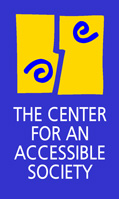
DISABILITY
ISSUES
INFORMATION
FOR JOURNALISTS
ABOUT
THE CENTER
Wed, 5 Mar 2003 -- Media Matters No. 25:
Freebies, give-aways and big documents"Information wants to be free." That early saying of Internet hackers offers a useful lesson to those of us who hope to interest reporters and editors in our research projects and data.
Don't expect reporters to purchase materials that you have produced in order to report on them. That's simply not the way the media works. The blunt truth is that reporters and editors are awash in free information sent to them by would-be sources. They get reports, documents, brochures, fancy flyers, CDs, booklets and books. Most are quickly routed to the "circular file." An earlier Media Matters warned that a news release of more than two pages was likely to be tossed; the warning goes double for "stuff." The sad but true news: they don't want it. Even if it explains your project in just the right words. Even if it has elaborate charts and data tables. Even if it's beautifully printed, in full color.
A second truth: The first truth doesn't always hold. Sometimes a really eye-catching booklet or pamphlet dealing with an unusual topic of specific interest will capture a specific reporter's attention, at least briefly. We sent a booklet on "Visitability" to 50 real estate/architecture reporters and the issue piqued the interest of several. But we also emailed them the exact URL link to the on-line version.
Another truth: while reporters very rarely pay for documents or books, most reputable newspapers, to avoid any appearance of conflict of interest, have a policy forbidding their reporters, editors or columnists from accepting free samples of products (food, wine, tickets, technology, software). You know those surveys in Consumer Reports? All their products are randomly purchased off the shelf.
What, then, to do to get reporters to look at your material? There's a simple answer today: use your website. Reporters more than most people use the Internet and increasingly get the information they need from competent websites. If your project's website is clear, easily navigable and contains original material or background information, the best thing you can do is send a BRIEF news release -- we're talking just a few short paragraphs, preferably by email -- and provide the specific link to the document you want them to have.
But DO be sure to give a *DIRECT LINK*. Remember, reporters are busy people, with many claims on their attention. Anything you do to slow down their information-gathering process will end up hurting you. Don't give them the link to your site and expect them to browse it to find what you want them to find. Give them the exact URL (and it goes without saying: click on the link to make SURE the one you're giving them ACTUALLY WORKS).
Another thing to remember: PDF files are *NOT* the best way to transmit information. They are big; they are "buggy" and, most important, they remain inaccessible to a wide range of screen readers and voice output interfaces. Provide your information and documents in HTML, or in plain text (not .doc, either, if you can avoid it.) Whoever works with your website on access issues can explain simple ways to do this.
Be sure to keep your website updated. And it's also a good idea to put a date -- like a newspaper story's dateline-- at the start or end of any document online, that way reporters -- and everyone else -- will know exactly how current the information is.
Contact us at info@accessiblesociety.org